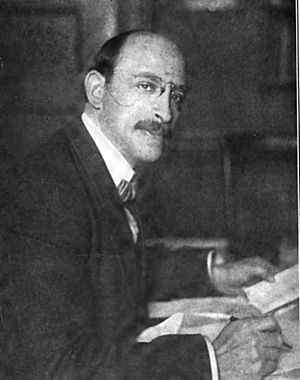Alexander Berkman facts for kids
Quick facts for kids
Alexander Berkman
|
|
|---|---|

Alexander Berkman, September 1912
|
|
| Born |
Ovsei Osipovich Berkman
November 21, 1870 Vilnius, Vilna Governorate, Russian Empire
|
| Died | June 28, 1936 (aged 65) Nice, France
|
| Burial place | Cochez Cemetery, Nice, France |
| Occupation |
|
| Family | Mark Natanson (uncle) |
| Signature | |
Alexander Berkman (born November 21, 1870 – died June 28, 1936) was a writer and activist. He was born in Russia and later moved to America. He was a key figure in the anarchist movement in the early 1900s. He was known for his strong beliefs and his many writings.
Contents
Biography
Early Life in Russia
Alexander Berkman was born into a wealthy Jewish family. This was in a city called Vilna, which was part of the Russian Empire. Today, Vilnius is the capital of Lithuania. He was the youngest of four children. His father, Osip Berkman, was a successful leather merchant. His mother, Yetta, came from a well-off family too.
In 1877, his father was allowed to move the family to Saint Petersburg. This city was usually off-limits for Jewish families. In Saint Petersburg, Ovsei changed his name to Alexander. His family and friends often called him Sasha. The Berkmans lived a comfortable life with servants and a summer home. Alexander went to a special school called a gymnasium. There, he received a classical education alongside other children from important families.
Becoming a Rebel
When Alexander was 12, his father passed away. The family had to sell their business. They also lost the right to live in Saint Petersburg. His mother moved the family to Kovno, where her brother lived. Alexander was a very promising student. But after his father's death, he started spending more time reading novels.
Soon, Alexander joined a group at school. They read and talked about revolutionary books. These books were banned by the new tsar, Alexander III. Alexander shared these forbidden materials with other students. He even wrote some of his own radical ideas. He printed them using supplies he took from the school.
Moving to America
Alexander's mother died in 1887. His uncle, Nathan Natanson, became responsible for him. Alexander did not like his uncle's desire for order. His uncle worried that Alexander's radical ideas would bring shame to the family. Later that year, Alexander was caught stealing school exams. He was also caught trying to bribe a handyman. Because of this, he was expelled from school.
Alexander decided to move to the United States. In early 1888, his brother went to Germany to study. Alexander went with him and then traveled to New York City.
Activism in America
In New York City, Alexander Berkman became deeply involved in the anarchist movement. He became a lifelong friend of another famous anarchist, Emma Goldman. In 1892, he took part in a protest during the Homestead strike. He tried to attack a businessman named Henry Clay Frick. For this, he spent 14 years in prison. His time in prison later became the topic of his first book, Prison Memoirs of an Anarchist.
After he was released from prison, Berkman worked as an editor. He edited Emma Goldman's anarchist magazine, Mother Earth. Later, he started his own magazine called The Blast.
Deportation and Later Life
In 1917, Berkman and Goldman were sent to jail for two years. They were accused of working against the new draft for World War I. After their release, they were arrested again. Along with many others, they were sent away to Russia.
At first, Berkman and Goldman supported Russia's Bolshevik revolution. But they soon became disappointed. They spoke out against the new government's use of force. They also opposed how the government treated other revolutionaries. They left Russia in late 1921. In 1925, Berkman wrote a book about his experiences there. It was called The Bolshevik Myth.
While living in France, Berkman continued his work for the anarchist movement. He wrote an important book explaining anarchist ideas. It was called Now and After: The ABC of Communist Anarchism.
Final Years
Berkman spent his last years working as an editor and translator. He and his partner, Emmy Eckstein, often moved to find cheaper places to live in Nice, France. A friend, Modest Stein, who was a successful artist, sent Berkman money each month to help him.
In the 1930s, Berkman's health got worse. He had two operations in early 1936, but they did not help. After the second surgery, he was in bed for many months. He was in constant pain and relied on friends for money and Emmy's care. Alexander Berkman died on June 28, 1936.
Emma Goldman arranged his funeral. Berkman had wanted his ashes to be buried in Chicago. He wanted to be near the graves of the Haymarket defendants who had inspired him. But Emma could not afford this. Instead, Berkman was buried in a common grave in Cochez Cemetery in Nice.
Berkman passed away just weeks before the start of the Spanish Revolution. This was a time when anarchist ideas were put into practice in Spain. In July 1937, Emma Goldman wrote that seeing his ideas in action "would have made [Berkman] feel young again and given him new strength, new hope. If only he had lived a little longer!"
Images for kids
-
Berkman speaking at a May Day rally in New York's Union Square, 1914
-
Berkman's experiences in Bolshevist Russia were the basis of The Bolshevik Myth.
-
Berkman (right) and Nestor Makhno in Paris, 1927
See also
 In Spanish: Alexander Berkman para niños
In Spanish: Alexander Berkman para niños








